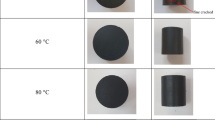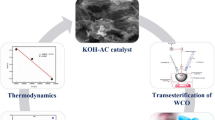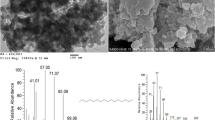Abstract
Present study deals with a holistic approach to bioenergy production from a single-celled green algae Chlorella pyrenoidosa aiming to valorise all biomass components. In the first phase, the microalgae biomass was used to produce biodiesel in a microwave-assisted biodiesel reactor by in situ transesterification process. The biomass residue left after biodiesel production was pyrolyzed in a fixed bed pyrolysis reactor at various isothermal temperatures (400, 450, 500, 550, and 600°C) in second phase. The pyrolysis reaction results revealed that the highest bio-oil yield was 35.33 wt% along with 51.23 wt% biochar and 13.44 wt% pyrolysis gas at 500 °C. FTIR and GC–MS analyses of bio-oil confirm the existence of hydrocarbons as well as oxygenated chemicals like esters, phenols, and acid derivatives. Furthermore, the fuel properties of bio-oil as well as biodiesel e.g. viscosity, density, calorific value, flash point, and pour point were determined using standard procedures (ASTM D6751–02, EN–14214, and IS) and confirmed to be appropriate for stationary engine application. On the other hand, the biochar characterisation showed that it holds good potential for usage as a biocoal in industrial boilers/power plants or cooking stoves. Hence, this study demonstrates the utilization of Chlorella pyrenoidosa microalgae for production of eco-friendly renewable fuels as well as a wide range of value-added co-products with a zero-waste biorefinery approach.
Graphical abstract







Similar content being viewed by others
References
Khan K, Kumar G, Sharma AKAK et al (2018) Performance and emission characteristics of a diesel engine using complementary blending of castor and karanja biodiesel. Biofuels 9:53–60. https://doi.org/10.1080/17597269.2016.1256552
Sharma AK, Sharma PK, Chintala V et al (2020) Environment-friendly biodiesel/diesel blends for improving the exhaust emission and engine performance to reduce the pollutants emitted from transportation fleets. Int J Environ Res Public Health 17:.https://doi.org/10.3390/ijerph17113896
Chowdhury S, Dhawane SH, Jha B et al (2021) Biodiesel synthesis from transesterified Madhuca indica oil by waste egg shell–derived heterogeneous catalyst: parametric optimization by Taguchi approach. Biomass Convers Biorefinery 11:1171–1181. https://doi.org/10.1007/s13399-019-00512-3
Sharma AK, Sahoo PK, Singhal S (2016) Comparative evolution of biomass production and lipid accumulation potential of Chlorella species grown in a bubble column photobioreactor. Biofuels 7:1–11. https://doi.org/10.1080/17597269.2015.1138040
REN _21 (2021) GSR2021_Full_Report
Salakkam A, Sittijunda S, Mamimin C et al (2021) Valorization of microalgal biomass for biohydrogen generation: a review. Bioresour Technol 322:124533. https://doi.org/10.1016/j.biortech.2020.124533
Kumar Sharma A, Kumar Ghodke P, Manna S, Chen W-H (2021) Emerging technologies for sustainable production of biohydrogen production from microalgae: a state-of-the-art review of upstream and downstream processes. Bioresour Technol 342:126057. https://doi.org/10.1016/j.biortech.2021.126057
Bora AP, Dhawane SH, Anupam K, Halder G (2018) Biodiesel synthesis from Mesua ferrea oil using waste shell derived carbon catalyst. Renew Energy 121:195–204. https://doi.org/10.1016/j.renene.2018.01.036
Sharma AK, Sharma A, Singh Y, Chen WH (2021) Production of a sustainable fuel from microalgae Chlorella minutissima grown in a 1500 L open raceway ponds. Biomass Bioenerg 149:106073. https://doi.org/10.1016/j.biombioe.2021.106073
Rana MS, Prajapati SK (2021) Microwave-assisted pretreatment of wet microalgal biomass for recovery of biofuel precursors. Fuel 305:121610. https://doi.org/10.1016/j.fuel.2021.121610
Choudhary P, Malik A, Pant KK (2020) Exploration of a novel biorefinery based on sequential hydropyrolysis and anaerobic digestion of algal biofilm: a comprehensive characterization of products for energy and chemical production. Sustain Energy Fuels 4:1481–1495. https://doi.org/10.1039/c9se00939f
Rana MS, Prajapati SK (2021) Stimulating effects of glycerol on the growth, phycoremediation and biofuel potential of Chlorella pyrenoidosa cultivated in wastewater. Environ Technol Innov 24:102082. https://doi.org/10.1016/j.eti.2021.102082
Joshi K, Sharma V, Mittal S (2015) Social entrepreneurship through forest bioresidue briquetting: an approach to mitigate forest fires in Pine areas of Western Himalaya, India. Renew Sustain Energy Rev 51:1338–1344
Sharma AK, Sahoo PK, Singhal S, Patel A (2016) Impact of various media and organic carbon sources on biofuel production potential from Chlorella spp. 3 Biotech 6:1–12. https://doi.org/10.1007/s13205-016-0434-6
Sharma AK, Sahoo PK, Singal S (2015) Influence of different nitrogen and organic carbon sources on microalgae growth and lipid production. IOSR J Pharm Biol Sci 10:48–53
Sharma AK, Sahoo PK, Singhal S (2016) Comparative evolution of biomass production and lipid accumulation potential of Chlorella species grown in a bubble column photobioreactor. Biofuels 7:. https://doi.org/10.1080/17597269.2015.1138040
Sharma AK, Sahoo PK, Singhal S, Patel A (2016) Impact of various media and organic carbon sources on biofuel production potential from Chlorella spp. 3 Biotech 6:. https://doi.org/10.1007/s13205-016-0434-6
Yadav M, Chavan SB, Singh R et al (2019) Experimental study on emissions of algal biodiesel and its blends on a diesel engine. J Taiwan Inst Chem Eng 96:160–168. https://doi.org/10.1016/j.jtice.2018.10.022
Deshmukh S, Kumar R, Bala K (2019) Microalgae biodiesel: a review on oil extraction, fatty acid composition, properties and effect on engine performance and emissions. Fuel Process Technol 191:232–247. https://doi.org/10.1016/j.fuproc.2019.03.013
Singh R, Kumar A, Chandra Sharma Y (2019) Biodiesel production from microalgal oil using Barium–Calcium–Zinc mixed oxide base catalyst: optimization and kinetic studies. Energy Fuels 33:1175–1184
Qu S, Chen C, Guo M et al (2021) Microwave-assisted in-situ transesterification of Spirulina platensis to biodiesel using PEG/MgO/ZSM-5 magnetic catalyst. J Clean Prod 311:127490. https://doi.org/10.1016/j.jclepro.2021.127490
Ahmed M, Abdullah A, Patle DS et al (2021) Feedstocks, catalysts, process variables and techniques for biodiesel production by one-pot extraction-transesterification: a review. Springer International Publishing
Talebian-Kiakalaieh A, Amin NAS, Mazaheri H (2013) A review on novel processes of biodiesel production from waste cooking oil. Appl Energy 104:683–710. https://doi.org/10.1016/j.apenergy.2012.11.061
Sharma AK, Sahoo PK, Singhal S, Joshi G (2016) Exploration of upstream and downstream process for microwave assisted sustainable biodiesel production from microalgae Chlorella vulgaris. Bioresour Technol 216:793–800. https://doi.org/10.1016/j.biortech.2016.06.013
Joshi G, Rawat DS, Sharma AK, Pandey JK (2016) Microwave enhanced alcoholysis of non-edible (algal, jatropha and pongamia) oils using chemically activated egg shell derived CaO as heterogeneous catalyst. Bioresour Technol 219:.https://doi.org/10.1016/j.biortech.2016.08.011
Singh A, Olsen SI (2011) A critical review of biochemical conversion, sustainability and life cycle assessment of algal biofuels. Appl Energy 88:3548–3555. https://doi.org/10.1016/j.apenergy.2010.12.012
Rajesh Banu J, Preethi, Kavitha S et al (2020) Microalgae based biorefinery promoting circular bioeconomy-techno economic and life-cycle analysis. Bioresour. Technol. 302
Francavilla M, Kamaterou P, Intini S et al (2015) Cascading microalgae biorefinery: fast pyrolysis of Dunaliella tertiolecta lipid extracted-residue. Algal Res 11:184–193
Kim S-S, Ly HV, Kim J et al (2015) Pyrolysis of microalgae residual biomass derived from Dunaliella tertiolecta after lipid extraction and carbohydrate saccharification. Chem Eng J 263:194–199
Sánchez-Bayo A, López-Chicharro D, Morales V et al (2020) Biodiesel and biogas production from Isochrysis galbana using dry and wet lipid extraction: a biorefinery approach. Renew Energy 146:188–195. https://doi.org/10.1016/j.renene.2019.06.148
Monlau F, Suarez-Alvarez S, Lallement A et al (2021) A cascade biorefinery for the valorization of microalgal biomass: biodiesel, biogas, fertilizers and high valuable compounds. Algal Res 59:.https://doi.org/10.1016/j.algal.2021.102433
Ji X, Liu B, Chen G, Ma W (2015) The pyrolysis of lipid-extracted residue of Tribonema minus in a fixed-bed reactor. J Anal Appl Pyrolysis 116:231–236
Miao X, Li P, Li R, Zhong J (2011) In situ biodiesel production from fast-growing and high oil content chlorella pyrenoidosa in rice straw hydrolysate. J Biomed Biotechnol 2011:.https://doi.org/10.1155/2011/141207
Karpagam R, Jawaharraj K, Gnanam R (2021) Review on integrated biofuel production from microalgal biomass through the outset of transesterification route: a cascade approach for sustainable bioenergy. Sci Total Environ 766:144236. https://doi.org/10.1016/j.scitotenv.2020.144236
Tsigie YA, Huynh LH, Ismadji S et al (2012) In situ biodiesel production from wet Chlorella vulgaris under subcritical condition. Chem Eng J 213:104–108. https://doi.org/10.1016/j.cej.2012.09.112
Ghodke PK, Sharma AK, Pandey JK et al (2021) Pyrolysis of sewage sludge for sustainable biofuels and value-added biochar production. J Environ Manage 298:113450. https://doi.org/10.1016/j.jenvman.2021.113450
Choudhary P, Assemany PP, Naaz F et al (2020) A review of biochemical and thermochemical energy conversion routes of wastewater grown algal biomass. Sci Total Environ 726:137961. https://doi.org/10.1016/j.scitotenv.2020.137961
Sati H, Mitra M, Mishra S, Baredar P (2019) Microalgal lipid extraction strategies for biodiesel production: a review. Algal Res 38:101413
Pali HS, Sharma A, Singh Y, Kumar N (2020) Sal biodiesel production using Indian abundant forest feedstock. Fuel 273:117781
Wu H, Miao X (2014) Biodiesel quality and biochemical changes of microalgae Chlorella pyrenoidosa and Scenedesmus obliquus in response to nitrate levels. Bioresour Technol 170:421–427
Zheng H, Yin J, Gao Z et al (2011) Disruption of Chlorella vulgaris cells for the release of biodiesel-producing lipids: a comparison of grinding, ultrasonication, bead milling, enzymatic lysis, and microwaves. Appl Biochem Biotechnol 164:1215–1224
Amin M, Chetpattananondh P, Ratanawilai S (2019) Application of extracted marine Chlorella sp. residue for bio-oil production as the biomass feedstock and microwave absorber. Energy Convers Manag 195:819–829
Gong Z, Fang P, Wang ZZ et al (2020) Pyrolysis characteristics and products distribution of Haematococcus pluvialis microalgae and its extraction residue. Renew Energy 146:2134–2141
Wang K, Brown RC, Homsy S et al (2013) Fast pyrolysis of microalgae remnants in a fluidized bed reactor for bio-oil and biochar production. Bioresour Technol 127:494–499
Tang H, Abunasser N, Garcia MED et al (2011) Potential of microalgae oil from Dunaliella tertiolecta as a feedstock for biodiesel. Appl Energy 88:3324–3330. https://doi.org/10.1016/j.apenergy.2010.09.013
Sun J, Norouzi O, Mašek O (2021) A state-of-the-art review on algae pyrolysis for bioenergy and biochar production. Bioresour Technol 346:126258. https://doi.org/10.1016/j.biortech.2021.126258
Casazza AA, Spennati E, Converti A, Busca G (2020) Production of carbon-based biofuels by pyrolysis of exhausted Arthrospira platensis biomass after protein or lipid recovery. Fuel Process Technol 201:106336
Chintala V, Kumar S, Pandey JK et al (2017) Solar thermal pyrolysis of non-edible seeds to biofuels and their feasibility assessment. Energy Convers Manag 153:.https://doi.org/10.1016/j.enconman.2017.10.029
Dhyani V, Bhaskar T (2017) A comprehensive review on the pyrolysis of lignocellulosic biomass. Renew Energy. https://doi.org/10.1016/j.renene.2017.04.035
Converti A, Casazza AA, Ortiz EY et al (2009) Chemical engineering and processing : process intensification effect of temperature and nitrogen concentration on the growth and lipid content of Nannochloropsis oculata and Chlorella vulgaris for biodiesel production. 48:1146–1151.https://doi.org/10.1016/j.cep.2009.03.006
Azizi K, Moraveji MK, Najafabadi HA (2018) A review on bio-fuel production from microalgal biomass by using pyrolysis method. Renew Sustain Energy Rev 82:3046–3059
Chintala V, Sharma AK, Karn A et al (2019) Utilization of biomass-derived pyro-oils in compression ignition (CI) engines–recent developments. Energy Sources, Part A Recover Util Environ Eff. https://doi.org/10.1080/15567036.2019.1683652
Shahbeig H, Nosrati M (2019) Pyrolysis of municipal sewage sludge for bioenergy production : thermo-kinetic studies, evolved gas analysis, and techno-socio-economic assessment. Renew Sustain Energy Rev 119:109567. https://doi.org/10.1016/j.rser.2019.109567
Khan K, Kumar G, Sharma AK et al (2018) Performance and emission characteristics of a diesel engine using complementary blending of castor and Karanja biodiesel. Biofuels 9:. https://doi.org/10.1080/17597269.2016.1256552
Yu KL, Show PL, Ong HC et al (2018) Biochar production from microalgae cultivation through pyrolysis as a sustainable carbon sequestration and biorefinery approach. Clean Technol Environ Policy 20:2047–2055
Pradhan D, Singh RK, Bendu H, Mund R (2016) Pyrolysis of Mahua seed ( Madhuca indica ) – production of biofuel and its characterization. Energy Convers Manag 108:529–538. https://doi.org/10.1016/j.enconman.2015.11.042
Chintala V, Kumar SS, Pandey JKJK et al (2017) Solar thermal pyrolysis of non-edible seeds to biofuels and their feasibility assessment. Energy Convers Manag 153:482–492. https://doi.org/10.1016/j.enconman.2017.10.029
Rajamohan S, Kasimani R (2018) Analytical characterization of products obtained from slow pyrolysis of Calophyllum inophyllum seed cake: study on performance and emission characteristics of direct injection diesel engine fuelled with bio-oil blends. Environ Sci Pollut Res 25:9523–9538
Shahid A, Ishfaq M, Ahmad MS et al (2019) Bioenergy potential of the residual microalgal biomass produced in city wastewater assessed through pyrolysis, kinetics and thermodynamics study to design algal biorefinery. Bioresour Technol 289:121701
Yang C, Li R, Zhang B et al (2019) Pyrolysis of microalgae: a critical review. Fuel Process Technol 186:53–72
Lee XJ, Ong HC, Gan YY et al (2020) State of art review on conventional and advanced pyrolysis of macroalgae and microalgae for biochar, bio-oil and bio-syngas production. Energy Convers Manag 210:112707. https://doi.org/10.1016/j.enconman.2020.112707
Bazargan A, Rough SL, McKay G (2014) Compaction of palm kernel shell biochars for application as solid fuel. Biomass Bioenerg 70:489–497. https://doi.org/10.1016/j.biombioe.2014.08.015
Zhao M, Ma X, Liao X et al (2022) Characteristics of algae-derived biochars and their sorption and remediation performance for sulfamethoxazole in marine environment. Chem Eng J 430:133092. https://doi.org/10.1016/j.cej.2021.133092
Sun J, Norouzi O, Mašek O (2022) A state-of-the-art review on algae pyrolysis for bioenergy and biochar production. Bioresour Technol 346:.https://doi.org/10.1016/j.biortech.2021.126258
Acknowledgements
The authors are very thankful to Dr. S. J. Chopra, (Chancellor, UPES), Dr. Sunil Rai (VC, UPES), and Dr. D. K. Avasthi (Dean, R & D) for providing continued support and motivation for this project. We are also thankful for Central Instrumentation Centre (CIC), R & D, UPES for FTIR and GC-MS analysis.
Author information
Authors and Affiliations
Contributions
Amit Kumar Sharma: conceptualization; methodology; data curation; writing—original draft preparation. Pankaj Kumar Sharma: project administration, resources, supervision. Praveen Kumar Ghodke: methodology, software, investigation. Arivalagan Pugazhendhi, writing-reviewing and editing, Leonidas Matsakas: supervision, reviewing, and editing. Alok Kumar Patel: software; writing—reviewing and editing,
Corresponding author
Ethics declarations
Conflict of interest
The authors declare no competing interests.
Additional information
Publisher's note
Springer Nature remains neutral with regard to jurisdictional claims in published maps and institutional affiliations.
Highlights
• Renewable fuels were generated from microalgae by transesterification and pyrolysis pathways.
• In situ transesterification of CP resulted in 19.84% biodiesel yield.
• Pyrolysis of CPMR yields 35.33 wt%, 51.23 wt% biochar, and 13.44 wt% syngas at 500 °C.
• One hundred kilograms of CP biomass can be converted into 15.47 kg biodiesel, 29.67 kg bio-oil, and 43.03 kg biochar.
• Blends of diesel, biodiesel, and bio-oil showed good potential for CI engine application.
Supplementary Information
Below is the link to the electronic supplementary material.
Rights and permissions
About this article
Cite this article
Sharma, A.K., Ghodke, P., Sharma, P.K. et al. Holistic utilization of Chlorella pyrenoidosa microalgae for extraction of renewable fuels and value-added biochar through in situ transesterification and pyrolysis reaction process. Biomass Conv. Bioref. 14, 5261–5274 (2024). https://doi.org/10.1007/s13399-022-02713-9
Received:
Revised:
Accepted:
Published:
Issue Date:
DOI: https://doi.org/10.1007/s13399-022-02713-9




